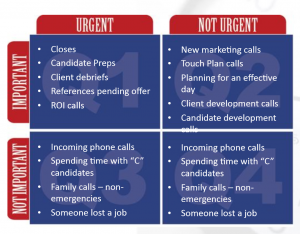At the NAPS conference in Houston, TX, one of my favorite speakers was Jon Bartos of The Global Performance Group, who spoke on the multi-million dollar producer’s guide to time management. As independent recruiters, each day, we go into work with a clear mind, a set plan of things to accomplish, of calls to make, and business development plans. Two hours later after reading and handling three unpredicted emails and reading on the latest sports scandal, we realize our plans are not quite panning out. Here are some tips from Jon Bartos as to how to manage that time more closely.
Planning is the foundation of your success or failure, and by structuring your day, you can avoid the latter. Reserve the morning for marketing and get the important tough stuff done first. Set daily goals based off of yearly goals, break down that $5,000,000 revenue into smaller targets to stay on point. 80% of sales people waste time selling to the wrong targets, so make sure you know who is taking up your time and market to those that will help you reach your goals.
Understand the four quadrants of efficiency to keep your day on task. Schedule your email and handle the important ones first. Here is a chart showing the four quadrants and how to prioritize:
By handling emails and daily tasks according to these quadrants, you are taking care of what needs to be immediately handled and not letting the random email ADHD take over your day and time management.
Track your results with a performance management system to see what activities are powering your business and which activities are unproductive or taking away from building revenue. Do not allow yourself to close a day without sticking to your activities, even the typical, “I’ll do it tomorrow” should be crossed from your vocabulary.
Finally, always remember that selling time should be valued and scheduled the most, because this is your $1000 dollar activity versus your $10 dollar activity, make it a priority and hit those goals, 2014 is not over yet!












